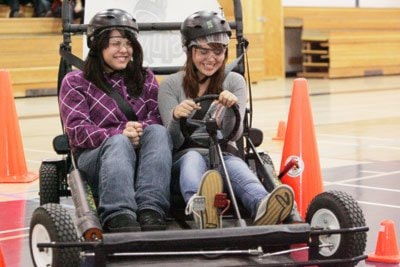In the gymnasium of Vanier Catholic Secondary, two students whizzed around a small course of orange cones in a black go-cart.
From a remote control, Const. Ben Douglas pressed a button labeled “intoxicated,” and the two students instantly veered out of control.
The Simulated Impaired Driving Experience, the new $20,000 anti-impaired driving tool of Mother’s Against Drunk Driving, had made its point.
“We’re looking to get the word out and let people know what it’s like as either an impaired driver or the passenger of an impaired driver,” said Jan Trim, president of the Whitehorse Chapter of MADD.
Nearby, a student in “intoxicated mode” plowed the cart into four traffic cones.
“She’s already hit what could be four little kids or puppies,” said Trim.
“Oh man, my hair,” moaned a nearby student as the protective helmet crushed his carefully spiked hairstyle.
Outside the gymnasium was a grouping of MADD’s educational “stations” — each with a different message about impaired driving.
Five students staggered around, attempting to perform simple tasks while wearing “blur goggles” — specially designed glasses to simulate drunken vision.
A computer program called “fatal reflections” took photos of a student’s face and then superimposed post-crash injuries — along with a written narrative detailing the crash’s consequences for the victim.
“It’s very sad, it usually ends in death, so the person really gets drawn into that,” said Trim.
Another computer program calculates a student’s blood-alcohol content based on their weight, gender and number of drinks consumed.
“But isn’t it different if you drink different stuff, like coolers and stuff?” asked a student.
For some students, the MADD programs, while informative, were hard to relate to the real-life situations and consequences of driving under the influence.
“Really, this is just half a day off from school,” said a student.
“I don’t know if the message actually translates; you wouldn’t normally think, ‘Oh, I’m drunk, I better think back to the MADD program,’” said the student who was worried about crushing his hair.
When partying, he said he rarely plans ahead — but that’s because he’s confident that a designated driver will be available — or that he will be able to spend the night.
“At the end of the day, it’s not hard to find a designated driver; one of your friends isn’t going to be drinking,” said another student.
Before students took to the go-cart, MADD representatives asked the group of assembled students to raise their hand if they, or someone they knew, had ever been involved in a crash where alcohol was involved.
“We don’t call them accidents, we call them crashes, because an accident is something that isn’t preventable,” said Melissa, the MADD representative.
Almost half the students raised their hands.
“When you’re growing up, they say (drunk driving) is a thing that you’re not ever supposed to do,” said one student later.
“But then you do it and you realize that it’s not as bad as they said,” he added.
“But it could be very bad.”
Whatever the indifferent reactions of students to MADD’s afternoon lineup of anti-impaired driving programs, the simple fact remains that drunk driving rates among youth are going down.
“We see impaired driving more with the older generation of drivers,” said Const. Ben Douglas, the RCMP liaison for the event.
“Most young drivers, because of programs like this, come on to the road aware of the perils of impaired driving — and they take measures to make sure they’re not put in that position,” he said.
Trim credits the reductions in driving rates among youth to the “designated driver” concept. Students are not told to abstain from drinking — an impossibility — instead, they are merely asked to make a simple pre-night-of-drinking driving arrangement, said Trim.
The concepts have permeated to the point where they are an integral component to teenagers’ social fabric, said Bill Willoughby, a teacher at Vanier.
“Drunk driving is so socially unacceptable now that I think we have that going for us when we do a curriculum like this,” said Willoughby.
A waiting student agreed, but credited it more to the sage advice of friends and family, rather than the efforts of MADD.
“When someone you really respect gives you a good reason not to (drink and drive), then you start to think about it a lot more,” he said.
“But if people come and just try to scare you, it’s not going to work,” he added.
Contact Tristin Hopper at
tristinh@yukon-news.com
